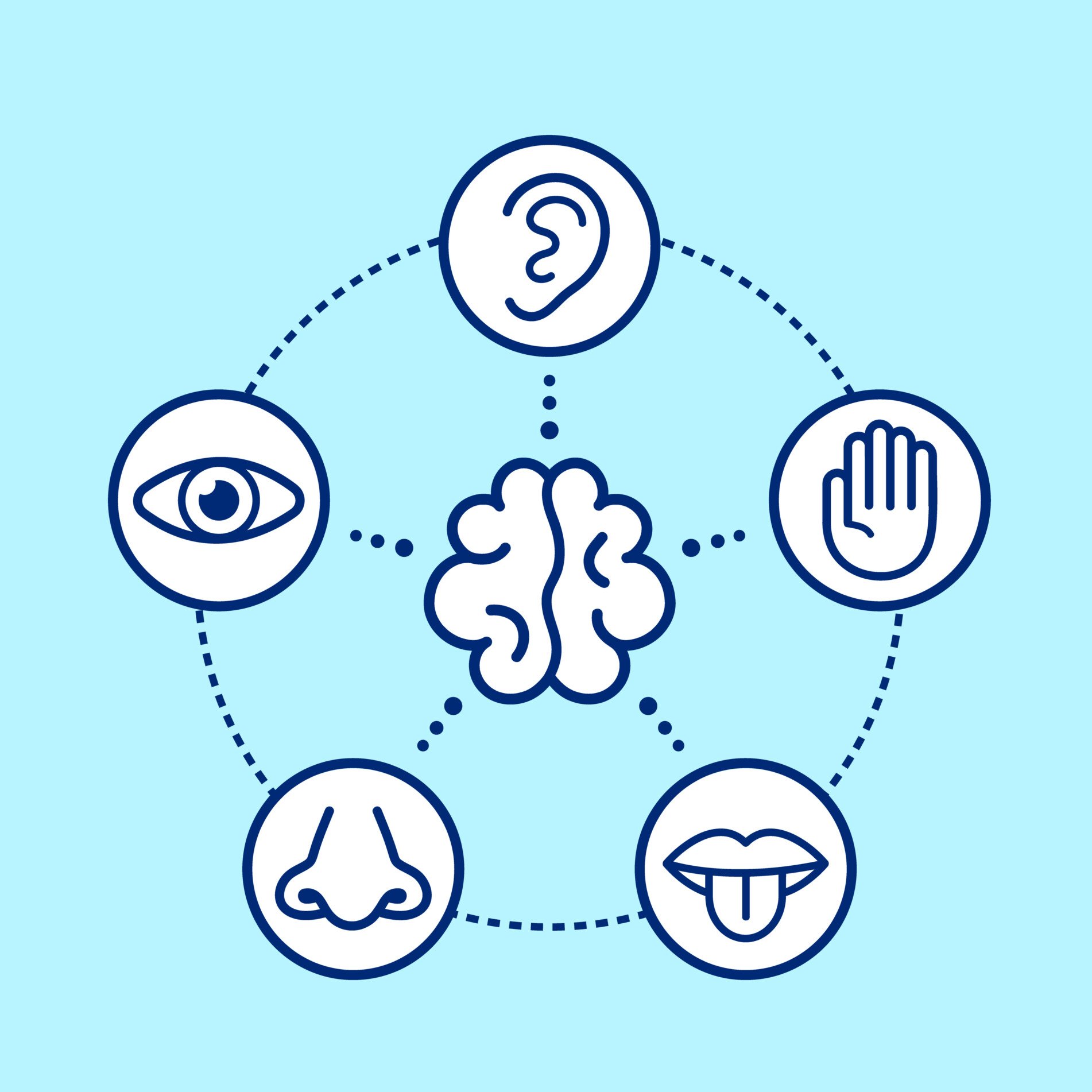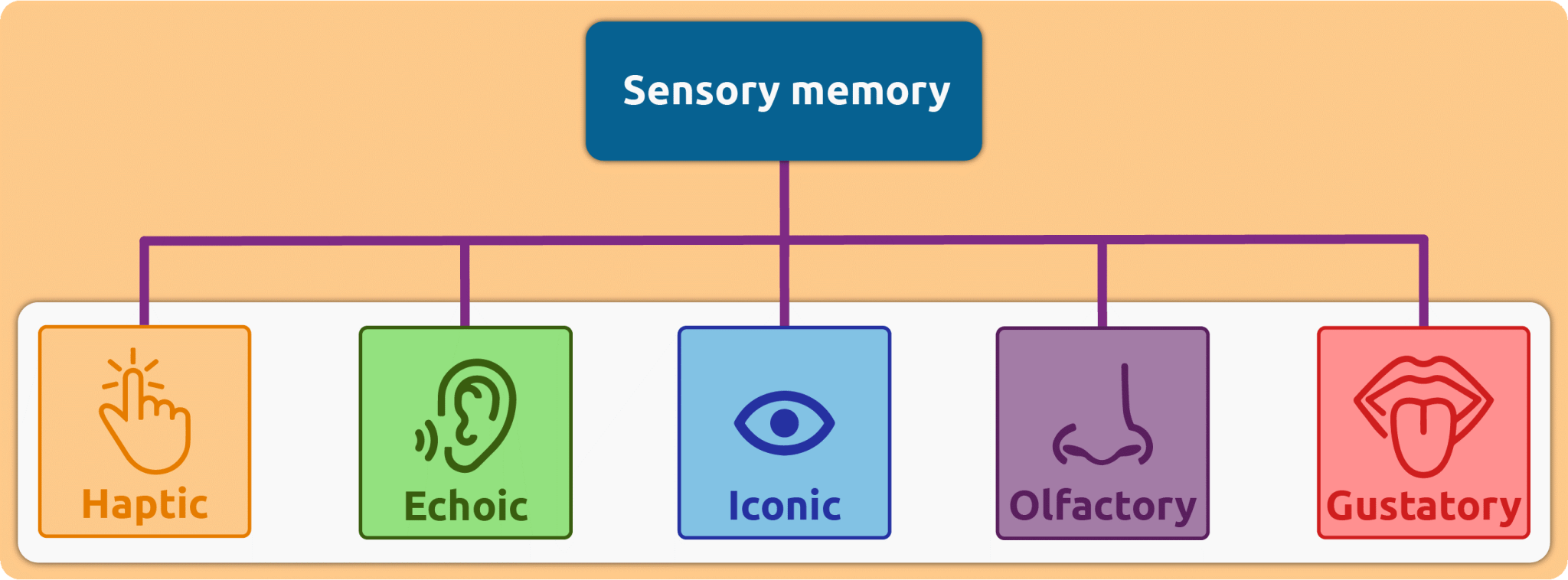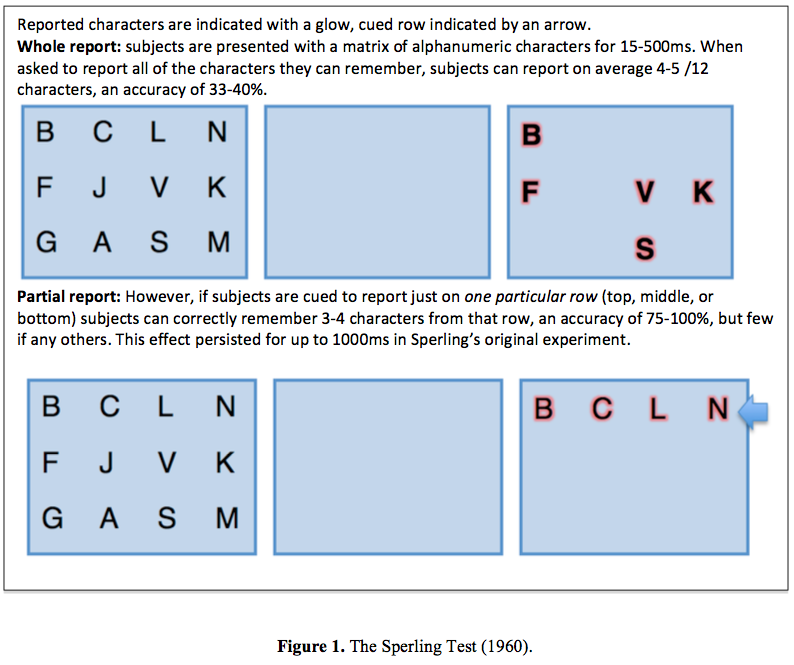On This Page:
Sensory memory in psychology refers to the short-term retention of sensory information, like sights, sounds, and smells, immediately following stimuli input.
It’s a crucial stage in memory processing that briefly stores vast amounts of sensory data before it’s selectively filtered into conscious awareness as working memory.
Key Takeaways
- Sensory memory is a very short-term memory store for information being processed by the sense organs. Sensory memory has a limited duration to store information, typically less than a second.
- It is the first store of the multi-store model of memory.
- Sensory memory can be divided into subsystems called the sensory registers: asiconic, echoic, haptic, olfactory, and gustatory.
- Generally, iconic memory deals with visual sensing, echoic memory deals with auditory sensing, and haptic memory deals with tactile sensing.
- George Sperling’s experiments provided crucial initial insight into the workings of sensory memory.

What is Sensory Memory?
Sensory memory is a brief storage of information in humans wherein information is momentarily registered until it is recognized and perhaps transferred to short-term memory (Tripathy & Öǧmen, 2018).
Sensory memory allows for retaining sensory impressions following the cessation of the original stimulus (Coltheart, 1980).
Throughout our lives, we absorb tremendous information via our visual, auditory, tactile, gustatory, and olfactory senses (Coltheart, 1980).
Since it is impossible to permanently register each and every impression we have captured via these senses, as we momentarily focus on a pertinent detail in our environment, our sensory memory registers a brief snapshot of our environment, lasting for several hundred milliseconds.
Attention is the first step in remembering something, and if a person’s attention is focused on one of the sensory stores, then the data is transferred to short-term memory.
Types of Sensory Memory
Sensory memory can be divided into subsystems called the sensory registers: such as iconic, echoic, haptic, olfactory, and gustatory.

Iconic Memory
Iconic memory is the visual sensory memory register that stores visual images after its stimulus has ceased (Pratte, 2018). While iconic memory contains a huge capacity, it declines rapidly (Sperling, 1960).
Information stored in iconic memory generally disappears within half a second (depending on the brightness).
This fleeting storage of visual information allows the brain to process and understand visual stimuli from our environment. It’s named ‘iconic’ due to its relation to visual icons or images.
Activity
Close your eyes for one minute, and hold your hand about 25cm from your face ad then open and close your eyes. You should see an image of your hand that fades away in less than a second (Ellis, 1987).
Examples of Iconic Memory
- Seeing an ant on the wall
- Seeing an aircraft in the sky as you walk down the road
- Seeing the change in traffic lights
A recent study examined the hypothesis that iconic memory comprises fine-grained and coarse-grained memory traces (Cappiello & Zhang, 2016). The study employed a mathematical model to quantify each trace.
The outcome suggested that the dual-trace iconic memory model might be superior to the single-trace model.
Echoic Memory
Echoic memory is a type of sensory memory that specifically pertains to auditory information (sounds). It refers to the brief retention of sounds in our memory after the original noise has ceased.
This short-term auditory memory, which can last several seconds, allows the brain to process and comprehend sounds and spoken language even after the sound source is no longer present.
Activity
Clap your hands together once and see how the sound remains for a brief time and then fades away.
Examples of Echoic Memory
- Hearing the bark of a dog
- Hearing the whistle of a police officer
- Hearing the horn of a car
The information which we hear enters our organism as sound waves. These are sensed by the ears’ hair cells and processed afterward in the temporal lobe.
The processing of echoic memories generally takes 2 to 3 seconds (Darwin, Turvey & Crowder, 1972).
The recent use of the Mismatch Negativity (MMN) paradigm, which employs MEG and EEG recordings, has unveiled many characteristics of echoic memory (Sabri, Kareken, Dzemidzic, Lowe & Melara, 2003).
Consequently, language acquisition and change detection have been identified as some crucial functions of echoic memory.
Additionally, a study on echoic sensory alterations suggests that a presentation of a sound to a participant is sufficient to shape a trace of echoic memory which can be compared with a different sound (Inui, Urakawa, Yamashiro, Otsuru, Takeshima, Nishihara & Kakigi, 2010).
Moreover, a study of language acquisition indicates that children who start speaking late are likely to have an abridged echoic memory (Grossheinrich, Kademann, Bruder, Bartling & Suchodoletz, 2010).
Furthermore, lesions on or damage to the parietal lobe, the hippocampus, or the frontal lobe, would likely shorten echoic memory or/and slow its reaction time (Alain, Woods & Knight, 1998).
Haptic Memory
Haptic memory involves tactile sensory memories procured via the sense of touch through the sensory receptors, which can detect manifold sensations such as pain, pressure, pleasure, or itching (Dubrowski, 2009).
These memories tend to last for about two seconds.
It enables us to combine a series of touch sensations and to play a role in identifying objects we can’t see. E.g., Playing a song on the guitar or a sharp pencil on the back of the hand.
Examples of Haptic Memory
- Feeling a raindrop on your skin
- Feeling a key while typing on the keyboard
- Feeling a string as you play the guitar
The information which enters through sensory receptors travels via the spinal cord’s afferent neurons to the parietal lobe’s postcentral gyrus through the somatosensory system (Shih, Dubrowski & Carnahan, 2009; D’Esposito, Ballard, Zarahn & Aguirre, 2002).
fMRI studies suggest that certain neurons within the prefrontal cortex engage in motor preparation and sensory memory. Motor preparation provides a significant link to haptic memory’s role in motor responses.
Olfactory Memory
Olfactory sensory memory involves the brief retention of smell stimuli. It’s a type of sensory memory that allows us to retain and process odors momentarily.
Examples of Olfactory Memory
- Smelling the scent of chlorine and instantly remembering childhood spent at a public swimming pool.
- The scent of a specific soap brand triggers memories of a hotel stay during a memorable vacation.
- The aroma of fresh-cut grass evokes memories of playing in the backyard during summer.
- The smell of books evokes memories of studying in a library or a favorite reading spot.
- The smell of rain on dry soil, known as petrichor, triggers memories of rainy days.
This form of memory is powerful due to the strong links between olfaction and emotion/memory centers in the brain.
Gustatory Memory
Gustatory sensory memory is the temporary storage and recall of taste information. It refers to our ability to hold briefly and process tastes after we’ve experienced them.
This type of sensory memory is closely linked with olfactory (smell) memory due to the interconnected nature of taste and smell, and it can powerfully evoke recollections of specific events, places, or experiences associated with certain tastes.
Examples of Gustatory Memory
- Tasting a specific brand of ice cream and being reminded of your childhood when you used to eat it.
- The taste of a particular spice or ingredient in a dish reminds you of your grandmother’s cooking.
- Tasting an exotic fruit and recalling a trip to a foreign country.
- The flavor of a certain candy triggers memories of Halloween trick-or-treating.
- Tasting a type of wine and remembering a special occasion or celebration where it was served.
Sperling’s Experiments
In 1960, the cognitive psychologist George Sperling conducted an experiment using a tachistoscope to briefly present participants with sets of 12 letters arranged in a matrix that had three rows of letters (Schacter, Gilbert & Wegner, 2011).
The participants of the study were asked to look at the letters for approximately 1/20th of a second and recall them soon afterward.
During this procedure, described as free recall, the participants were able, on average, to recall 4 to 5 of the 9 letters which they had seen (Sperling, 1960).
While the conventional psychological view at the time would have pointed out that this outcome was merely the result of the participants’ not being able to retain all the letters in their minds, Sperling seemed to believe that the participants had actually mentally registered all the letters which they had seen (Sperling, 1960).
Sperling hypothesized that the participants had forgotten this information while attempting to recall it. In other words, Sperling held that all of the nine letters were, in fact, stored in the participants’ memory for a very short time, but that this memory had faded away. Hence, the participants could recall only 4 or 5 of the 9 letters.

Afterward, Sperling ran a second, slightly different experiment using the partial report technique. As earlier, the participants were shown three rows of letters for 1/20th of a second (Sperling, 1960).
However, this time, as the letters disappeared, the participants heard either a low-pitched, a medium-pitched, or a high-pitched tone.
The participants who heard the low-pitched tone had to report the bottom row, those who heard the medium-pitched tone had to report the middle row, and those who heard the high-pitched tone had to report the top row.
The individuals managed to recall the letters if the tone was sounded within 1/3rd of a second following the display of the letters (Sperling, 1960). However, the ability to report the letters declined drastically as the interval increased beyond 1/3rd of a second—an interval of more than one second rendered recalling almost impossible.
The experiment indicated that the participants could recall the information as long as they were focused on the pertinent row before the memory of the letters vanished.
Hence, they could not recall the letters if the tone was heard after the memory had faded.
FAQs
Which process transfers information from sensory memory to short-term memory?
The process that transfers information from sensory memory to short-term memory is known as attention.
When we pay attention to a particular sensory stimulus, that information is transferred from the sensory memory (iconic, echoic, haptic, olfactory, or gustatory) to the short-term memory, also known as working memory, where it becomes part of our conscious awareness and can be further processed and encoded for longer-term storage.
How long does information last in sensory memory?
The duration of information in sensory memory varies based on the type of sensory input.
Iconic (visual) memory lasts about 100-200 milliseconds, echoic (auditory) memory can last up to 3-4 seconds, while haptic (touch), olfactory (smell), and gustatory (taste) memories have less defined durations but are generally considered brief.
If attention is not focused on these sensory impressions, they disappear quickly and are replaced by new sensory input.
What is the difference between iconic memory and echoic memory?
Iconic and echoic memory are types of sensory memory, but they differ in the sensory modality they process. Iconic memory refers to briefly retaining visual information, lasting about 100-200 milliseconds.
On the other hand, echoic memory relates to auditory information, maintaining sounds for a slightly longer duration, approximately 3-4 seconds. Their difference lies in the type of sensory input they handle – visual versus auditory.
In which memory store does information first have meaning?
Information first attains meaning in short-term memory, also known as working memory.
This is where the conscious processing of information occurs. Unlike sensory memory, which merely stores raw sensory input, short-term memory interprets and assigns meaning to these stimuli, allowing us to understand and respond to our environment.
Encoding in working memory can also facilitate the transfer of information to long-term memory for more permanent storage.
References
Alain, C., Woods, D. L., & Knight, R. T. (1998). A distributed cortical network for auditory sensory memory in humans. Brain research, 812 (1-2), 23-37.
Cappiello, M., & Zhang, W. (2016). A dual-trace model for visual sensory memory. Journal of Experimental Psychology: Human Perception and Performance, 42 (11), 1903.
Coltheart, M. (1980). Iconic memory and visible persistence. Perception & psychophysics, 27 (3), 183-228.
Darwin, C. J., Turvey, M. T., & Crowder, R. G. (1972). An auditory analogue of the Sperling partial report procedure: Evidence for brief auditory storage. Cognitive Psychology, 3 (2), 255-267.
D’Esposito, M., Ballard, D., Zarahn, E., & Aguirre, G. K. (2000). The role of prefrontal cortex in sensory memory and motor preparation: an event-related fMRI study. Neuroimage, 11 (5), 400-408.
Grossheinrich, N., Kademann, S., Bruder, J., Bartling, J., & Von Suchodoletz, W. (2010). Auditory sensory memory and language abilities in former late talkers: a mismatch negativity study. Psychophysiology, 47 (5), 822-830.
Inui, K., Urakawa, T., Yamashiro, K., Otsuru, N., Takeshima, Y., Nishihara, M., … & Kakigi, R. (2010). Echoic memory of a single pure tone indexed by change-related brain activity. BMC neuroscience, 11 (1), 1-10.
Pratte, M. S. (2018). Iconic memories die a sudden death. Psychological science, 29 (6), 877-887.
Sabri, M., Kareken, D. A., Dzemidzic, M., Lowe, M. J., & Melara, R. D. (2004). Neural correlates of auditory sensory memory and automatic change detection. Neuroimage, 21 (1), 69-74.
Shih, R., Dubrowski, A., & Carnahan, H. (2009, March). Evidence for haptic memory. In World Haptics 2009-Third Joint EuroHaptics conference and Symposium on Haptic Interfaces for Virtual Environment and Teleoperator Systems (pp. 145-149). IEEE.
Sperling, G. (1960). The information available in brief visual presentations. Psychological monographs: General and applied, 74 (11), 1.
Tripathy, S. P., & Öǧmen, H. (2018). Sensory memory is allocated exclusively to the current event-segment. Frontiers in psychology, 9, 1435.
Further Information
- Sperling, G. (1960). The information available in brief visual presentations. Psychological monographs: General and applied, 74(11), 1.
- Öğmen, H., & Herzog, M. H. (2016). A new conceptualization of human visual sensory-memory. Frontiers in Psychology, 7, 830.
- Sligte, I. G., Vandenbroucke, A. R., Scholte, H. S., & Lamme, V. (2010). Detailed sensory memory, sloppy working memory. Frontiers in Psychology, 1, 175.


